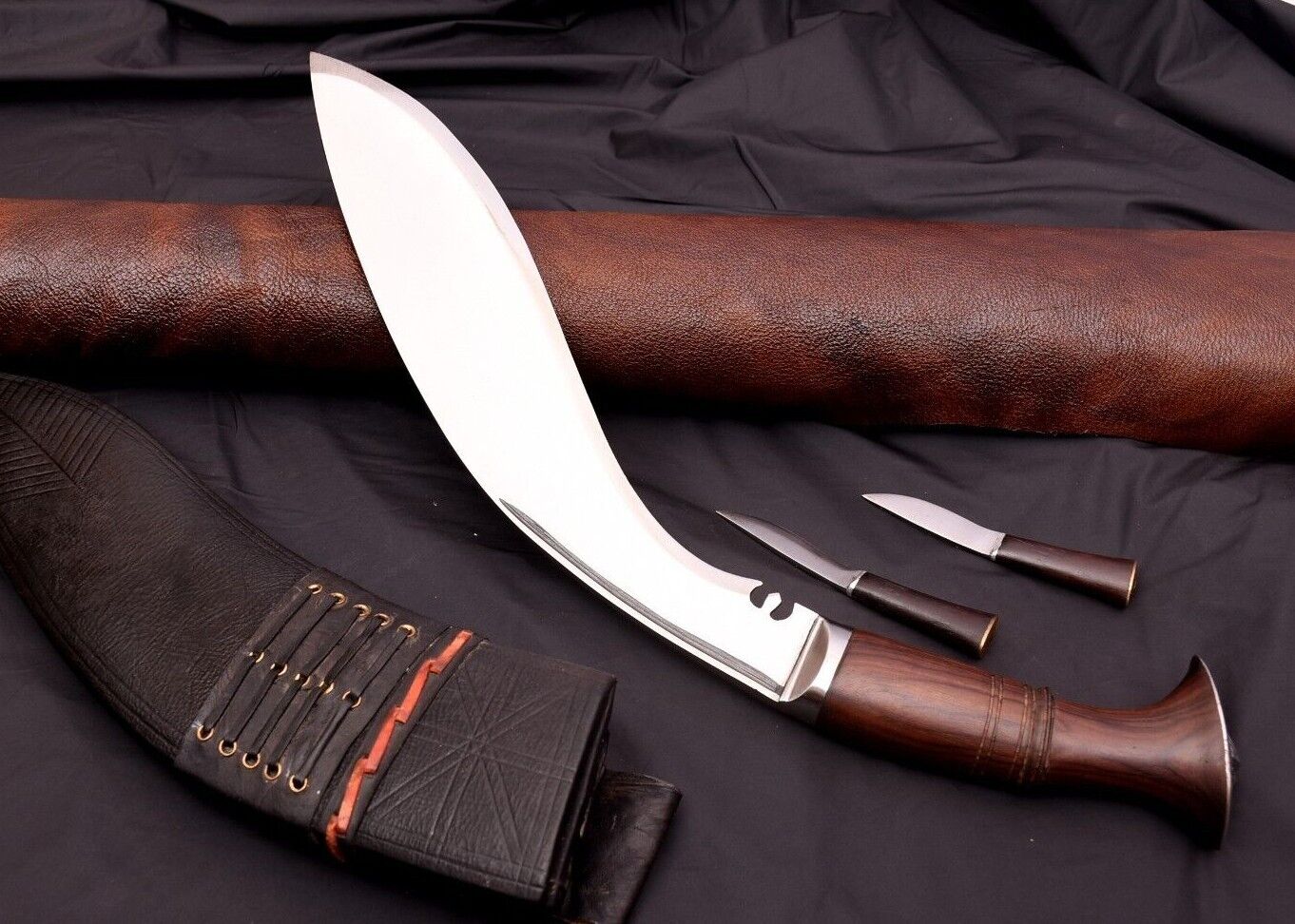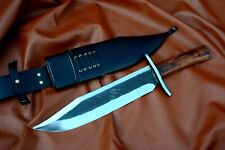When you click on links to various merchants on this site and make a purchase, this can result in this site earning a commission. Affiliate programs and affiliations include, but are not limited to, the eBay Partner Network.
About Khukuri:Thekukri is a type of machete originating from the Indian subcontinent, and istraditionally associated with the Nepali-speaking Gurkhas of Nepal. The knifehas a distinct re-curve in its blade. It serves multiple purposes as a meleeweapon and also as a regular cutting tool throughout most of South Asia. Theblade has traditionally served the role of a basic utility knife for theGurkhas. The kukri is the national weapon of Nepal, and consequently is acharacteristic weapon of the Nepalese Army.
Therehave been, and still are many myths surrounding the kukri since its earliest recordeduse in the 7th century most notably that a traditional custom revolves aroundthe blade in which it must draw blood, owing to its sole purpose as a fightingweapon, before being sheathed. However, they are frequently used as regularutility tools. Extraordinary stories of their use in combat by Gurkhas maycontribute to this misconception. The kukri, khukri, and kukkri spellings areof Indian English origin, with the original Nepalese English spelling beingkhukuri.
Akhukuri is a curved short sword with a broad blade used especially by Gurkhas.Actual origin of khukuri is less known but common belief is that the modernblade is the transformed form of ancient Greek Kopis carried to the Indiansubcontinent by the troops of Alexander the Great some 2500 years ago.
Thiskhukuri delivers longer cut as it possesses a much longer blade. This khukuriis especially used to butcher animals, cut trees. This khukuri is used to chopwood, meat, bushes etc.
Twosmall knives namely Karda & Chakmak are also part of this kukri. Karda is asmall sharp knife which can be used to cut small woods, dig holes, skinning outanimals. Similarly, we have Chakmak that can be used for honing the blade and produce sparks.
This 12 inch Balance Khukuri-Light Version with heavy duty khukuri was made from 5160 leaf spring of truck with balance water tempered on the edge of the khukuri. It has double fullers with 5.5 inch handle with polished blade. Handle was made from rosewood and yak bone.
The blade serves for the purpose of hunting and military. The rings and grooves on the handle gives the traditional looks and provides more friction to get hold of the khukuri effectively. It is used to chop and split wood, meat, bushes etc. Two small knives namely Karda & Chakmak are also part of this kukri. Karda is a sharp small knife which can be used to cut small woods ,twigs , dig holes, skinning out animals. Similarly, we have Chakmak that can be used for honing the blade.
KhukuriSpecification:
The thickness of the Spine: 8 mm
Length of the Blade 10-Inch
Length with the Sheath: 16-Inch
Weight of the Blade: 690-750 gm
Overall Weight: 750-850 gm
Blade material: High carbon steel
Sheath material: Wood and water buffalo leather
Handle material: Rosewood and aluminumsat Rivet
Hardness of Steel:
Spine: 22-25 RC
Belly: 45-46 RC
Edge: 58-60 RC
Whatis khukuri famous for?
Itis famous for its traditional metal works especially its unique khukuri. TheBhojpure khukuri which gets its name from this very village is boarder, thickerand mostly come in standard size of 10-12” long (blade).
Whydoes a kukri have two small knives?
Whatare two accompanying knives of a kukri for? Karda and Chakmak are the twoaccompanying knives that come at the back of the sheath of a kukri. “Karda” isa small utility knife and “Chakmak” is an emergency sharpening knife. Karda hasone sharp edge where as Chakmak\'s both sides are blunt in order tosharpen/strop.
Manufacture:TheBiswakarma Kami (caste) are the traditional inheritors of the art ofkukri-making. Modern kukri blades are often forged from spring steel, sometimescollected from recycled truck suspension units. The tang of the blade usuallyextends all the way through to the end of the handle. The small portion of thetang that projects through the end of the handle are hammered flat to securethe blade. Kukri blades have a hard, tempered edge and a softer spine. Thisenables them to maintain a sharp edge, yet tolerate impacts.
Kukrihandles, usually made from hardwood or buffalo horn, are often fastened with akind of tree sap called laha (also known as \"Himalayan epoxy\"). Witha wood or horn handle, the tang may be heated and burned into the handle toensure a tight fit, since only the section of handle which touches the blade isburned away. In more modern kukri, handles of cast aluminums or brass arepress-fitted to the tang; as the hot metal cools it shrinks, locking onto theblade. Some kukri (such as the ones made by contractors for the modern IndianArmy), have a very wide tang with handle slabs fastened on by two or morerivets, commonly called a full tang (panawal) configuration.
Traditionalprofiling of the blade edge is performed by a two-man team; one spins agrinding wheel forwards and backwards by means of a rope wound several timesaround an axle while the sharpener applies the blade. The wheel is made by handfrom fine river sand bound by laha, the same adhesive used to affix the handleto the blade. Routine sharpening is traditionally accomplished by passing achakmak over the edge in a manner similar to that used by chefs to steel theirknives.Kukriscabbards are usually made of wood or metal with an animal skin or metal orwood covering. The leather work is often done by a Sarki.
Classificationof Khukuri:Kukriscan be broadly classified into two types: Eastern and Western. The Easternblades are originated and named according to the towns and villages of EasternNepal.
TheEastern Khukuris are Angkhola Khukuri, Bhojpure Khukuri, Chainpure Khukuri,Cheetlange (Chitlange) Khukuri, Chirwa (Chiruwa) Khukuri, Dhankute Khukuri,Ganjawla Khukuri, Panawala Khukuri, Sirupate Khukuri translates as Siru grassleaf like. Khukuris made in locations like Chainpur, Bhojpur, and Dhankuta inEastern Nepal are excellent and ornate knives.
Westernblades are generally broader. Occasionally the Western style is called Budhuna,(referring to a fish with a large head), or baspate (bamboo leaf) which refersto blades just outside the proportions of the normal Sirupate blade. Despitethe classification of Eastern and Western, both styles of kukri appear to beused in all areas of Nepal.
Someof the famous knives of the world such as the Bowie Knife, the Stiletto, theScimitar, the Roman Sword, the Machete and so on have all, at one time or theother , played great historical roles as formidable weapons with men havedemonstrated raw power and courage during times of battle.
Thereis Khukuri named after Gorkhali General Amar Singh Thapa called Amar SinghThapa Khukuri. This Khukuri is modelled on the real Khukuri used by theGorkhali General. The real Khukuri used by Amar Singh Thapa is archived atNational Museum of Nepal and is more curvy in nature than other tradition’skhukri.
Usesof Khukri:Thekukri also sees standard service with various regiments and units within theIndian Army, such as the Assam Rifles, the Kumaon Regiment, the Garhwal Riflesand the various Gorkha regiments. Outside of its native region of South Asia,the kukri also sees service with the Brigade of Gurkhas in the British Army. Thekukri is the staple weapon of all Gurkha military regiments and unitsthroughout the world, so much so that some English-speakers refer to the weaponas a \"Gurkha blade\" or \"Gurkha knife\". The kukri oftenappears in Nepalese heraldry and is used in many traditional, Hindu-centricrites such as wedding ceremonies.
Utilityof Khukuri:Whilemost famed from use in the military, the kukri is the most commonly usedmultipurpose tool in the fields and homes in Nepal. Its use has varied frombuilding, clearing, chopping firewood, digging, slaughtering animals for food,cutting meat and vegetables, skinning animals, and opening cans. Its use as ageneral farm and household tool disproves the often stated \"taboo\"that the weapon cannot be sheathed \"until it has drawn blood\". Thekukri is versatile. It can function as a smaller knife by using the narrowerpart of the blade, closest to the handle. The heavier and wider end of theblade, towards the tip, functions as an axe or a small shovel.
BladeName of Kukri:
·Keeper (Hira Jornu): Spade/diamondshaped metal/brass plate used to seal the butt cap.
·Butt Cap (Chapri): Thick metal/brassplate used to secure the handle to the tang.
·Tang (Paro): Rear piece of the bladethat goes through the handle.
·Bolster (Kanjo): Thick metal/brass roundshaped plate between blade and handle made to support and reinforce thefixture.
·Spine (Beet): Thickest blunt edge of theblade.
·Fuller/Groove (Khol): Straight groove ordeep line that runs along part of the upper spine.
·Peak (Juro): Highest point of the blade.
·Main body (Ang): Main surface or panelof the blade.
·Fuller (Chirra): Curvature/hump in theblade made to absorb impact and to reduce unnecessary weight.
·Tip (Toppa): The starting point of theblade.
·Edge (Dhaar): Sharp edge of the blade.
·Belly (Bhundi): Widest part/area of theblade.
·Bevel (Patti): Slope from the main bodyuntil the sharp edge.
·Notch (Cho): A distinctive cut (numeric\'3 \'-like shape) in the edge. Used as a stopper when sharpening with thechakmak.
·Ricasso (Ghari): Blunt area between thenotch and bolster.
·Rings (Harhari): Round circles in thehandle.
·Rivet (Khil): Steel or metal bolt tofasten or secure tang to the handle.
·Tang Tail (Puchchar): Last point of thekukri blade.
Betterto die than be a coward-
\"Better to diethan be a coward\" is the motto of the world-famous Nepalese Gurkhasoldiers who are an integral part of the British Army. They still carry intobattle their traditional weapon - an 18-inch long curved knife known as thekukri.
Returnsand Shipping:- We ships each of our order with in onebusiness day and update tracking details of standard international shippingservice provider, we are happy and return our product and fully refund thepayment in case of any defect on our products. Please contact us within 14days.





